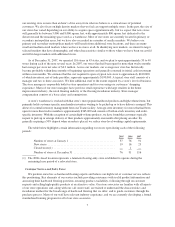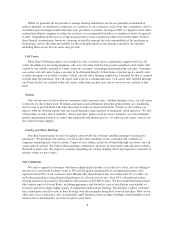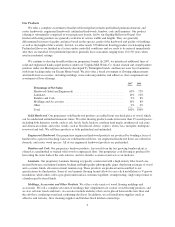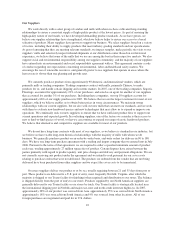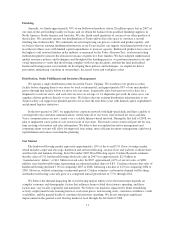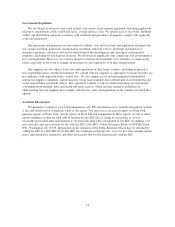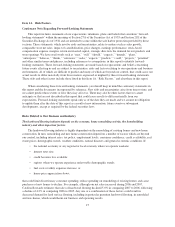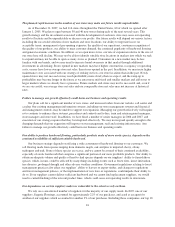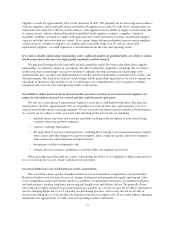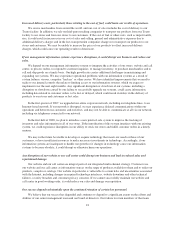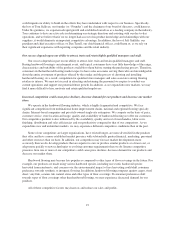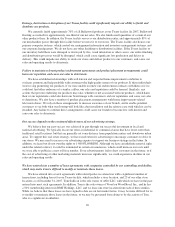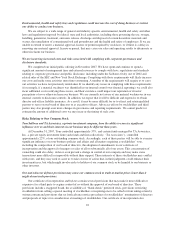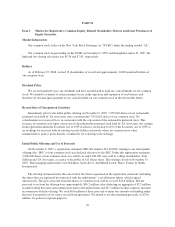Lumber Liquidators 2007 Annual Report Download - page 23
Download and view the complete annual report
Please find page 23 of the 2007 Lumber Liquidators annual report below. You can navigate through the pages in the report by either clicking on the pages listed below, or by using the keyword search tool below to find specific information within the annual report.suppliers account for approximately 66% of our purchases in 2007. We generally do not have long-term contracts
with our suppliers, and we typically obtain our hardwood supplies on an order-by-order basis, writing orders for
future deliveries from 90 to 180 days before delivery. Our suppliers may be unable to supply us in the future due
to various factors, which could include political instability in the supplier’s country, a supplier’s financial
instability, inability or refusal to comply with applicable laws, trade restrictions or tariffs, insufficient transport
capacity and other factors beyond our control. If we can no longer obtain merchandise from our major suppliers,
or they refuse to continue to supply us on commercially reasonable terms or at all, and we cannot find
replacement suppliers, we could experience a deterioration in our net sales and operating results.
If we fail to identify and develop relationships with a sufficient number of qualified mills, our ability to obtain
hardwood products that meet our high quality standards could be harmed.
We purchase flooring directly from mills located around the world. We believe that these direct supplier
relationships are relatively unique in our industry. In order to retain the competitive advantage that we believe
results from these relationships, we need to continue to identify, develop and maintain relationships with
qualified mills that can satisfy our high standards for quality and our requirements for hardwood in a timely and
efficient manner. The need to develop new relationships will be particularly important as we seek to expand our
operations in the future. Any inability to do so could reduce our competitiveness, slow our plans for further
expansion and cause our sales and operating results to deteriorate.
Our ability to obtain hardwood from abroad and the operations of many of our international suppliers are
subject to risks that are beyond our control and that could harm our operations.
We rely on a select group of international suppliers to provide us with hardwood products that meet our
specifications. In 2007, approximately 38% of our product was sourced from Asia, approximately 18% was
sourced from South America and approximately 9% was sourced from other locations outside of North America.
As a result, we are subject to risks associated with obtaining products from abroad, including:
• political unrest, terrorism and economic instability resulting in the disruption of trade from foreign
countries where our products originate;
• currency exchange fluctuations;
• the imposition of new laws and regulations, including those relating to environmental matters; imports,
duties, taxes and other charges on exports or imports; labor conditions; quality and safety standards;
trade restrictions; and restrictions on funds transfers;
• disruptions or delays in shipments; and
• changes in local economic conditions in countries where our suppliers are located.
These and other factors beyond our control could disrupt the ability of our suppliers to ship certain products
to us cost-effectively or at all, which could harm our operations.
Increased hardwood costs could harm our results of operations.
The cost of the various species of hardwood that we use in our products is important to our profitability.
Hardwood lumber costs fluctuate because of changes in domestic and international supply and demand, labor
costs, competition, market speculation, product availability, environmental restrictions, government regulation
and trade policies, weather conditions, processing and freight costs and delivery delays. We generally do not
have long-term supply contracts or guaranteed purchase amounts. As a result, we may not be able to anticipate or
react to changing hardwood costs by adjusting our purchasing practices, and we may not always be able to
increase the selling prices of our products in response to increases in supply costs. If we cannot address changing
hardwood costs appropriately, it could cause our operating results to deteriorate.
17


